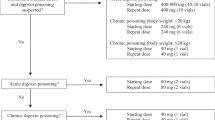Abstract
Effect of high-affinity mouse monoclonal antidigoxin antibodies D22 on digoxin-induced cardiac disturbances is studied in guinea pigs injected with 0.5 mg/kg digoxin. Five minutes after digoxin injection, bradycardia, isolated extrasystoles, conduction disturbances, and changes in theST segment andQRS complex appear; digoxin concentration attains 0.2–0.4 μg/ml. Antidigoxin monoclonal antibodies injected 10 min after digoxin slightly reduce heart rate, prevent isolated extrasystoles, improve atrioventricular conduction, and normalize the amplitude of theST segment and the shape of theQRS complex. Serum digoxin concentration decreases to 0.015–0.03 μg/ml. These data suggest that monoclonal antidigoxin antibodies can be effectively used in acute digoxin intoxication.
Similar content being viewed by others
References
N. P. Danilova, S. A. Yazynin, S. N. Eremenko, and R. G. Vasilov,Biotekhnologiya,4, 38–40 (1993).
N. P. Danilova,J. Immunol. Methods,173, 111–117 (1994).
K. Go, G. Kartha, and J. P. Chen,Acta Cryst.,B36, 1811–1819 (1980).
A. S. Hobbs and R. W. Albers,Annu. Rev. Biophys. Bioeng.,9, 259–291 (1980).
J. D. Horisberg,Ann. Rev. Physiol.,53, 565–584 (1991).
M. Humrick, Renaud, and D. M. Fambrough,J. Biol. Chem.,32, 24367–24373 (1993).
T. Ishii and K. Takeyasu,Proc. Natl. Acad. Sci. USA,90, 8881–89885 (1993).
P. D. Jeffrey, R. K. Strong, L. C. Sieker,et al., —Ibid. pp. 10310–10314, (.
K. Kawakami, S. Noguchi, M. Noda,et al., Nature,316, 733–736 (1985).
C. H. Pedemonte and J. N. Kaplan,Am. J. Physiol.,258, 1–23 (1990).
E. M. Price and J. B. Lingrel,Biochemistry,27, 8400–8408 (1988).
E. M. Price, D. A. Rice, and J. B. Lingrel,J. Biol. Chem.,265, 6638–6641 (1990).
P. J. Schultheis and J. B. Lingrel,Biochemistry,32, 544–550 (1993).
G. E. Shull, A. Schwartz, and J. B. Lingrel,Nature,316, 691–696 (1985).
S. J. Singer,J. Supramol. Struct. 6, 313–323 (1977).
J. C. Skou and J. G. Norby,Na +,K +-ATPase: Structure and Kinetics, New York (1979).
K. J. Sweadner and S. M. Goldin, —Ibid.,302, 777–783 (1980).
Author information
Authors and Affiliations
Additional information
Translated fromByulleten' Eksperimental'noi Biologii i Meditsiny, Vol. 125, No. 6, pp. 688–691, June, 1998
Rights and permissions
About this article
Cite this article
Pokid'ko, Y.N., Isaeva, S.A., Mnasina, E.E. et al. Effect of antidigoxin monoclonal antibodies on cardiac disturbances caused by high concentrations of digoxin. Bull Exp Biol Med 125, 612–615 (1998). https://doi.org/10.1007/BF02445255
Received:
Issue Date:
DOI: https://doi.org/10.1007/BF02445255




